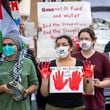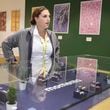NONFICTION
“Hidden Figures: The American Dream and the Untold Story of the Black Women Mathematicians Who Helped Win the Space Race”
by Margot Lee Shetterly
William Morrow
368 pages, $27.99
In 1966, when Nichelle Nichols debuted as Lt. Nyota Uhura in the premiere episode of “Star Trek,” an epochal moment for African-Americans in television, the black women at NASA’s Langley Research Center in Hampton, Va., had already successfully put the first American astronaut into orbit around the earth and were working furiously through the equations needed to land the first man on the moon.
Margot Lee Shetterly’s extraordinary book, “Hidden Figures: The American Dream and the Untold Story of the Black Women Mathematicians Who Helped Win the Space Race,” chronicles the incomparable story of the 50 black female mathematicians, engineers and scientists who worked at Langley’s flagship laboratory from 1943 to 1980.
She nimbly illustrates the paradox of the pursuit of high-level mathematics in the Jim Crow South, where NASA’s most venerated black researchers were forbidden from sharing the same bathrooms as its white employees. It’s a revelation made more remarkable given that in 1940, only 2 percent of black women earned college degrees.
White women began working as mathematicians or “computers” at Langley in 1935. In 1941, under pressure from Asa Philip Randolph, head of the largest black union in the country, Pres. Franklin D. Roosevelt signed executive orders that desegregated the defense industry and birthed the Fair Employment Practice Committee. Two years later, black female mathematicians, many with years of teaching experience, began arriving at the Langley Memorial Aeronautical Laboratory, an outpost of what was then NASA’s predecessor, the National Advisory Committee for Aeronautics (NACA).
Shetterly executes the monumental task of cataloging names and accomplishments with precision, fleshing out the support networks these women developed, the hours they toiled during six-day work weeks and the extra coursework they completed to earn promotions freely bestowed upon their white, male, oftentimes less skilled or less educated counterparts.
Among the first group was Dorothy Vaughn, a former high school math teacher hired in 1943 as a mathematician, alongside other graduates of historically black colleges and universities. She eventually became the section head of West Computing, the black sector of NACA. The “other” Dorothy, Dorothy Hoover, fluent in abstract mathematics, worked under Robert T. Jones and published research on his theory of triangular delta-shaped airplane wings. Engineer Mary Jackson wrote 12 scientific papers and didn’t hesitate to challenge her division chief when he mistakenly disputed her correct calculations.
In 1962, four years after NACA became NASA, Kathryn Johnson determined the trajectory calculations to send John Glenn on a three-orbit mission around the earth. When it came time to embark on the journey, Glenn requested, through a colleague, that Johnson run through the electronic computer’s figures once more to make sure there were no mistakes. In 1969, Johnson was part of the team to send Apollo 11, carrying Neil Armstrong, Michael Collins and Buzz Aldrin, to the moon.
Shetterly passionately expresses the high stakes of her book’s mission. “What I wanted was for them to have the grand, sweeping narrative they deserved, the kind of American history that belongs to the Wright Brothers and the astronauts, to Alexander Hamilton and Martin Luther King Jr. Not told as a separate history, but as a part of the story that we all know. Not in the margins, but at the very center, the protagonists of the drama.” Indeed, the author has deftly achieved an astonishing narrative that subverts the passages of history books and society’s collective assumption that black women in the Jim Crow South earned income solely as maids and caretakers to white families.
Impressively, the black scientists at Langley managed to become visionaries in the field of flight in spite of the state of Virginia’s intrepid resistance to integration. They were never deterred by rampant discrimination, never deferred to the frequent proclamations of their inferiority. “They would prove themselves equal or better, having internalized the Negro theorem of needing to be twice as good to get half as far.” These black women — who led Girl Scout troops and their sororities’ service drives, who spoke about science at public schools and never missed church on Sunday — understood their worth, their value, not merely as employees of NACA/NASA or as breadwinners for their families, but as potent leaders in their communities and pioneers for the country they proudly served.
If there are any shortcomings in “Hidden Figures,” they are well concealed. Shetterly’s account is exhaustive, her understanding of the culture and the climate of that hostile time, distinctive. She grew up in Hampton surrounded by black scientists – her father was one of NASA’s first black engineers. Her aunts and uncles were engineers or technologists. Her next-door neighbor taught physics at Hampton University. “The face of science was brown like mine … I knew so many African-Americans working in science, math and engineering that I thought that’s just what black folks did.”
“Hidden Figures” serves as the foundation for Shetterly’s next step to make the women of NACA and NASA known. In 2014 she founded The Human Computer Project, a searchable database of biographies for the women who worked at NACA or NASA from 1943 through 1970. “For too long,” she writes, “history has imposed a binary condition on its black citizens: either nameless or renowned, menial or exceptional, passive recipients of the forces of history or superheroes who acquire mythic status not just because of their deeds but because of their scarcity.”
It’s a pronouncement that begs the question — if history has failed to acknowledge this prominent chapter until now, what else has it left out?





